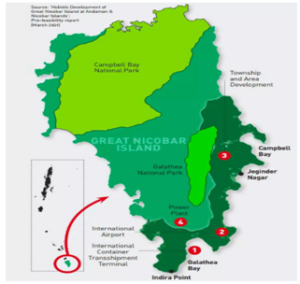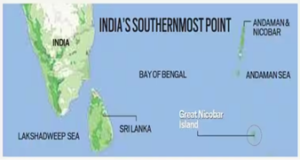Context:
The Union government’s Great Nicobar Project may see 9.64 lakh trees felled during its execution phase.
About Great Nicobar Project:

News Source: The Hindu
- Origin: The proposal to develop Great Nicobar Island was first introduced in the 1970s, emphasizing its role in national security and consolidating the Indian Ocean Region.
- However, increasing Chinese assertion in the Bay of Bengal and the Indo-Pacific has added great urgency to this imperative in recent years.
- It is a Rs 72,000 crore development project on the strategically important Great Nicobar Island.
- It has four components:
- a ₹35,000 crore transshipment port at Galathea Bay
- a dual-use military-civil international airport
- a power plant
- A greenfield township
- Implementation Agency: Andaman and Nicobar Islands Integrated Development Corporation

Image Credits: The Hindu
Significance of Great Nicobar Project:- Enhancing Great Nicobar role in Global Maritime Trade: It will allow Great Nicobar to participate in the regional and global maritime economy by becoming a major player in cargo transshipment.
- Electricity Generation: The project proposes the development of a power plant, with capacity to produce sufficient electrical power to run the new city.
- Employment Creation: More than one lakh new direct jobs and 1.5 lakh indirect jobs can be created on the island during the next 30 years.
- Tri service command: India’s strategic concerns in Southeast Asia and the Malacca Strait region are overseen by the Andaman & Nicobar Command (ANC), located in Port Blair.
- Helpful in Tackling Challenges: The island provides a natural base for India to tackle major challenges in the Indian Ocean region like piracy, smuggling, Sea lines of communication security and most crucially, intrusions by Chinese ships.
- In Sync with Act East Policy: One of the major objectives of the Act East policy is economic cooperation with Indo-Pacific countries, and the location of the Andaman and Nicobar Islands is a boon for the prospects of economic integration.
- Enhancing the Blue Economy: It will create an economic hub in the Andaman & Nicobar Islands, thereby giving a boost to the Blue Economy.
- Further, it will help in developing a free trade zone, limiting round-tripping and promotion as a Special Economic Zone (SEZ).
- Biodiversity Threat: The loss of tree cover will not only affect the flora and fauna on the island, it will also lead to increased runoff and sediment deposits in the ocean, impacting the coral reefs in the area.
- Balancing Ecological Fragility and Infrastructure Development: The proposed massive infrastructure development in an ecologically important and fragile region,
- The northern end of the project falls in the biosphere reserve, which means a part of this protected region will have to be allotted to the project.
- Tribal Rights: This project runs counter to the rights of vulnerable tribal communities and depend on the forests for survival.
- The Andaman and Nicobar Islands are home to 5 Particularly Vulnerable Tribal Groups: Great Andamanese, Jarwas, Onges, Shompens and North Sentinelese.
- Far-field afforestation: To recommend afforestation as a compensation for the loss of forest in the Great Nicobar Island is farcical. The EIA report says compensatory afforestation will be carried out in Haryana and Madhya Pradesh.
- Far-field afforestation, that too in areas that have no ecological comparison with Nicobar Island, makes no sense.
- Safeguarding Tribal Rights: Firstly, utmost respect for tribal rights is imperative, aligning with policies like the Shompen Policy of 2015. This policy underscores prioritizing tribal rights over extensive developmental projects.
- Environmental Impact Assessments: All construction activities within the framework of the Great Nicobar Development plan must strictly follow environmental impact assessments, as stipulated by the Environment Protection Act of 1986.
- These assessments not only improve the practicality of development but also reduce the possibility of substantial environmental harm.
- Adapting Eco-Friendly Practices: The creation of infrastructure should embrace eco-friendly practices, including strict adherence to the Green Rating for Integrated Habitat Assessment (GRIHA) code for building construction.
- Maintaining Transparency: NITI Aayog and associated planning entities should release comprehensive data on the reasoning, creation process, consulted groups, and related aspects to the public.
- This level of openness offers a comprehensive perspective for both critics and advocates.
Great Nicobar Island (GNI):

Image Credits: Indian Express |
Post Views: 163
